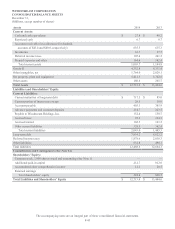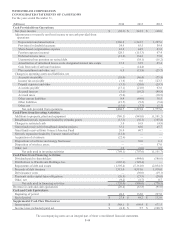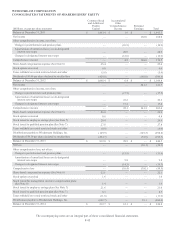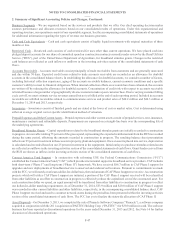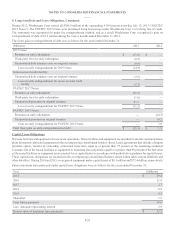Windstream 2014 Annual Report Download - page 164
Download and view the complete annual report
Please find page 164 of the 2014 Windstream annual report below. You can navigate through the pages in the report by either clicking on the pages listed below, or by using the keyword search tool below to find specific information within the annual report.
NOTES TO CONSOLIDATED FINANCIAL STATEMENTS
____
F-48
2. Summary of Significant Accounting Policies and Changes, Continued:
On February 22, 2012 and March 30, 2012, we completed the sales of wireless assets acquired from D&E Communications, Inc.
(“D&E”) and Iowa Telecommunications Services, Inc. (“Iowa Telecom”), respectively. In connection with these sales, we received
gross proceeds of approximately $57.0 million and recognized a gain of $5.2 million, net of transaction fees.
Goodwill and Other Intangible Assets – Goodwill represents the excess of cost over the fair value of net identifiable tangible and
intangible assets acquired through various business combinations. The cost of acquired entities at the date of the acquisition is
allocated to identifiable assets, and the excess of the total purchase price over the amounts assigned to identifiable assets has been
recorded as goodwill.
In accordance with authoritative guidance, goodwill is to be assigned to a company’s reporting units and tested for impairment at
least annually using a consistent measurement date, which for us is January 1st of each year. Goodwill is tested at the reporting
unit level. A reporting unit is an operating segment or one level below an operating segment, referred to as a component. A
component of an operating segment is a reporting unit for which discrete financial information is available and our executive
management team regularly reviews the operating results of that component. Additionally, components of an operating segment
can be combined as a single reporting unit if the components have similar economic characteristics. If the fair value of the reporting
unit exceeds its carrying value, goodwill is not impaired and no further testing is performed. If the carrying value of the reporting
unit exceeds its fair value, then a second step must be performed, and the implied fair value of the reporting unit’s goodwill must
be determined and compared to the carrying value of the reporting unit’s goodwill. If the carrying value of a reporting unit’s
goodwill exceeds its implied fair value, then an impairment loss equal to the difference will be recorded. Prior to performing the
two step evaluation, an entity has the option to perform a qualitative assessment to determine whether it is more likely than not
that the fair value of a reporting unit exceeds the carrying value. Under the qualitative assessment, if an entity determines that it
is more likely than not that a reporting unit’s fair value exceeds its carrying value, then the entity is not required to complete the
two step goodwill impairment evaluation.
During the fourth quarter of 2013, in connection with the disposal of our software business and changes in certain management
responsibilities, we reassessed our reporting unit structure as of November 30, 2013 and performed a quantitative analysis as of
that date. We estimated the fair value of our reporting units using an income approach supplemented with a market approach. The
income approach is based on the present value of projected cash flows and a terminal value, which represents the expected
normalized cash flows of the reporting unit beyond the cash flows from the discrete projection period of five years. We discounted
the estimated cash flows for each of the reporting units using a rate that represents a market participant’s weighted average cost
of capital commensurate with the reporting unit’s underlying business operations. Results of the income approach were corroborated
with estimated fair values derived from a market approach, which primarily included the use of comparable multiples of publicly
traded companies operating in businesses similar to ours. We also reconciled the estimated fair value of our reporting units to our
total market capitalization. Goodwill was assigned to the reporting units using a relative fair value allocation approach.
As of January 1, 2014, we determined that we had three reporting units, excluding corporate-level activities, to test for impairment.
After considering changes to assumptions used in our most recent quantitative testing completed as of November 30, 2013, including
general economic conditions, capital markets, telecommunications industry competition and trends, changes in common stock
prices, our results of operations, and the magnitude of the excess of the fair value over the carrying value of each of our reporting
units as determined in our most recent quantitative testing, we concluded that it is more likely than not that the fair value of our
reporting units is not less than their respective carrying values and, therefore, we did not perform a quantitative analysis.
Other intangible assets arising from business combinations such as franchise rights, customer lists, and cable franchise rights are
initially recorded at estimated fair value. We amortize customer lists using the sum-of-the-digits method over an estimated life or
9 to 15 years. All other intangible assets are amortized using a straight-line method over the estimated useful lives.
Net Property, Plant and Equipment – Property, plant and equipment are stated at original cost, less accumulated depreciation.
Property, plant and equipment consists of central office equipment, office and warehouse facilities, outside communications plant,
customer premise equipment, furniture, fixtures, vehicles, machinery, other equipment and software to support the business units
in the distribution of telecommunications products. The costs of additions, replacements, substantial improvements and extension
of the network to the customer premise, including related labor costs, are capitalized, while the costs of maintenance and repairs
are expensed as incurred. Depreciation expense amounted to $1,130.3 million, $1,049.7 million, and $955.6 million in 2014, 2013
and 2012, respectively.







